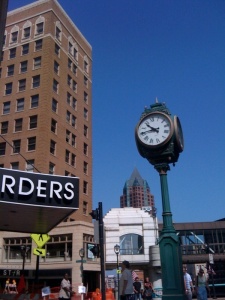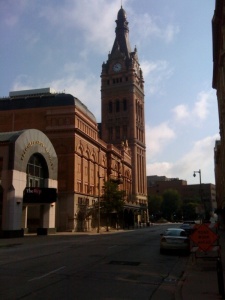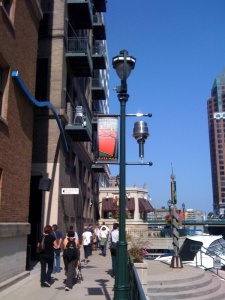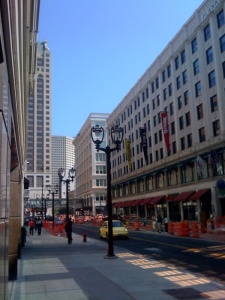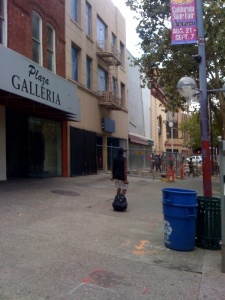I became acquainted with Storm Cunningham as a result of having purchased a book he authored entitled reWealth: Stake Your Claim in the $2 Trillion reDevelopment Trend That’s Renewing the World. And I’m so glad to have discovered it in the front section of Barnes and Noble Booksellers in Emeryville, California, for it provides a wealth of fresh insights on revitalizing the economy, environment, and quality of life in communities worldwide. I asked Storm if he would be allow me to interview him for my blog, and he was gracious enough to agree. I’m confident you’ll enjoy reading it. –Michael Scott
1.Cities throughout the nation are facing major budget shortfalls due to systemic economic issues. What advice do you have for city leaders seeking to jump start their redevelopment efforts amid limited funding?
They need to use this crisis to rid themselves of discredited economic development practices. For decades, planners and economic developers have been taught to do things backwards. The standard formula has been to “attract” employers via whatever means necessary, assuming that the resulting economic growth will improve quality of life.” This has resulted in a zero-sum, self-destructive “arms race”, whereby communities steal employers from each other by giving away years–or even decades–of tax revenues. It’s reported as “economic growth”, but it’s obviously no such thing for the state or the nation, as jobs just move from one place to another within their borders.
If one looks at the truly great “back-from-the-dead “success stories, we see the opposite strategy at work. Communities that have perpetuated their revitalization for a decade or more (Chattanooga, Bilbao, etc.), focused on improved quality of life first. This attracted high-quality employers who actually wanted to be there…who didn’t pull-up stakes as soon as the freebies ran out. That doesn’t mean that tax (and other) incentives aren’t a useful tool: but they shouldn’t be the only tool (as they often are), and they certainly should not comprise the heart of their strategy.
Chattanooga, for instance, recently attracted a $1 billion VW plant with incentives, but that was just the icing on their strategic cake. It was their leading-edge, long-standing, multi-faceted revitalization process that made the city desirable in the first place. After all, it wasn’t that long ago that Chattanooga was officially designated the filthiest city in the nation (one often had to drive with the headlights on in the middle of the day, the air pollution was so bad), with high crime, severe racial problems, and an industrial economy that was hemorrhaging over 1000 jobs annually. Now, Chattanooga is a world-renowned showcase of beauty, social harmony, low crime, and economic growth. You don’t get results like that just by offering tax incentives.
2.You are a huge advocate of public-private partnerships. Why do you believe these sorts of working relationships are vital to development efforts?
I’m a huge advocate of “renewal partnerships”, not necessarily the public-private partnerships in general. There has been vast abuse of the public trust in the name of “public-private partnering” over the past two decades. Clearly it’s not a partnership if the private sector takes no risk. Yet many so-called public-private partnerships have been little more than sweetheart deals for politically-connected firms. Or they result in effective monopolies for very large multinational firms that take advantage of desperate communities, who lack the legal expertise or wherewithal to defend their interests.
A “renewal partnership” is one that plays by the rules…the three “renewal rules” that my recent 6-year research project revealed to be the “secret formula” of the best revitalization successes. They are:
- ReWealth (basing wealth-creation primarily on the renewal of existing assets, as opposed to sprawl)
- Integration (of the natural, built, and socioeconomic environments)
- Engagement (of all stakeholders affected by–or involved in–the renewal process).
They each have value individually, but rapid, resilient renewal (which seems to be the universal goal of communities) only tends to happen when all three are combined.
3.What sorts of redevelopment trends do you see appearing on the horizon as our nation slowly climbs out of its recessionary doldrums?
This economic crisis could trigger the tipping point we’ve been working towards for 15-20 years. During that time, development and depletion (together known as “dewealth”) have been steadily giving way to rewealth (redevelopment and resource restoration). We’re moving from degenerative wealth-creation to regenerative wealth-creation. It’s not as if a fast-growing population on a planet of finite size has much choice: it’s an inevitable transition.
But dewealth is still the default mode of economic development in national policies, and rewealth is still the exception. In most older or larger cities, rewealth is already the default, but the states and feds are lagging. But where cities lead, nations eventually follow.
Now, we have a $787 billion economic stimulus package in the US that is heavily focused on restoration, redevelopment, remediation, infrastructure renewal, and the like— granted, the stimulus could have at least doubled its effectiveness by using the three renewal rules as a filter for projects. This runs counter to the current, brain-dead filter of “shovel-ready”, which is about doing things quickly, rather than doing the right things. But, it could still push the nation into a phase transition, whereby rewealth becomes the the default for economic growth, and dewealth the exception.
4.Are there any exciting or important new initiatives you know of that will accelerate dewealth/rewealth tipping point, and thus speed the revitalization of our communities?
The most exciting project I know of is one I’m actually involved in: the new Places To Invest initiative (www.PlacesToInvest.com). My firm is leading a global group of 20 communities–along with universities and expert advisers–in the creation of the first “community forecasting” service. It will help direct investment towards communities and regions that are prepared revitalize (or to continue their revitalization). This will help redevelopers and real estate investors avoid putting the right projects in the wrong community, or the right community at the wrong time.
A Renewal Quotient Test is under development. It produces a number–a renewal quotient (RQ)–that helps is measure and rank a community’s “renewal capacity”. Most communities invite reinvestment from the private sector, but are poorly prepared to be a good partner in their own revitalization. This often results in money-losing projects for redevelopers. Places To Invest will identify the best communities for such investments worldwide, and its Renewal Capacity Program (a series of 7 local workshops) helps poor-scoring communities become better places to invest. There’s already a free, 10-question online RQ Quiz, which generates an RQ score for a community based on a the quiz-taker’s perceptions. It’s a great way to familiarize oneself with the core principles on which the actual RQ Test will be based. [Readers can take the RQ Quiz here: http://www.surveygizmo.com/s/115736/rq-quiz%5D
Places To Invest is currently putting a strategic alliance together with one of the world’s largest investment banks (over a trillion dollars under management). They came to us, asking if we would help them find safer communities for their funds to invest in. Why? Because many of the pension funds and other investors whose money they invest are now demanding that their money go not to just “green” or “sustainable” investments, but to investments also help communities. We have meetings in Copenhagen and New York City scheduled in the coming weeks, and the alliance should be worked-out by the end of September. Look for a major public announcement by early next year or sooner.
5.The lack of economic hope continues to impact many of our nation’s urban inner-city areas. What can be done to reverse this trend?
It’s not just the populations of inner cities that are hope-starved. One of the problems we have–both nationally and globally–is a disease I call “reblindness”: we can’t see most of the restoration that’s going on around us. Our public accounting and reporting systems aren’t set up on a life cycle basis. They don’t clearly differentiate new development (at the beginning of the economic development cycle) from maintenance/conservation (in the middle of the life cycle) from restorative development (the “end” of the asset life cycle). All we ever hear about are “new housing starts”, “durable goods sales”, and the like.
Historic building reuse, infill, brownfields remediation, infrastructure renewal, ecological and watershed restoration, and all the other many and varied forms of restorative development are buried in budgets and are reported as “capital improvement” and “maintenance”. We are blind to the de-re shift that’s taking place. As a result, children and adults alike are lacking the data they need to believe that tomorrow’s world can be healthier, wealthier, and more beautiful. We need more than blind optimism if we are to to have a constructive attitude towards our future. If we could see the growth of restoration and redevelopment, we would be much more optimistic, and we would have excellent reasons to be so.
As for inner cities: they are actually in the best position to lead the way in business, education, science, and politics. Inner cities are a window on the future of the planet. Most of them have already come to grips with the fact that sustained economic growth can only be based on asset renewal, not on reflexively creating more and more of what few people want more of (as author Paul Hawken so brilliantly puts it). Inner cities know that the future of the planet is in renewing the value of the places we’ve already developed, and in repairing the damage we did to our natural resources along the way.
6.There’s much talk these days about how cities can become more sustainable in their approach to development? What sorts of benefits do you see ensuing from this movement?
“Sustainable development” was created as a compromise phrase. It was spawned some three decades ago, when environmentalists and business interests were at each others’ throats, and wouldn’t even talk to each other. Green leaders felt that “sustainable” was a less-threatening word for business executives, and they threw in “development” to show that greens weren’t against economic growth. But we’ve now outgrown that phrase.
Sustainable development has been a wonderful, noble, and necessary global dialog. But that’s all it is: a dialog. Sustainability isn’t a real thing…it isn’t a rigorous, measurable process by which you can actually do anything. At best, we can only say that something is “more sustainable” (that is, less damaging). But we can’t point to a project and say “that’s sustainable”. Sustainable for how long? 100 years? 10,000 years? Sustainable with how many people on the planet? 6 billion? 60 billion?
On the other hand, we can very easily point to a project and prove it’s restorative. We can document how many more fish are in a restored river. We can document how much less contamination there is in a remediated brownfield. We can document the increase in value of an adaptively-reused building, or vacant lot that’s been reused as an urban farm. The big problem with sustainable development is that it suffers from reblindness: it doesn’t differentiate among new development, maintenance/conservation, and restorative development. As a result, we see sprawling housing developments on top of valuable wetlands calling themselves “sustainable”, simply because they have photovoltaic panels on the roofs. Sure: green sprawl is better than brown sprawl, but that’s like inventing a healthier form of cancer, rather than a cure.
The “sweet spot” is where rewealth and green/clean technologies come together. The time is long past when merely doing less damage is enough. Every square meter of the planet’s land and every cubic meter of the planet’s water is now damaged, degraded, or polluted to some degree. The only way we can possible have a healthier, wealthier, more beautiful world is by revitalizing our cities and by restoring nature. That’s a perfectly legitimate basis for an economy: the global restoration economy currently accounts for some $2 trillion annually (not that anyone’s measuring it properly). That economy is tapping a global inventory of restorable assets estimated to be at least $100 trillion.
7.What drives your desire to make a difference through the work that you do? What is your greatest hope for the future of our world and planet?
I find excitement through earning a living in a way that engages my passions. And I’ve always loved nature. In other words, I enjoy being paid to do things that I would normally pay to do. I guess this started in the military, where I was a Green Beret scuba medic with the Army’s 7th Special Forces Group.They actually paid me to learn to scuba dive, paid me to learn to parachute, paid me to learn cross-country skiing, paid me to learn desert and jungle survival techniques, paid me to learn martial arts, paid me to learn medicine. Special Forces thus set my sights high. So, I later found myself earning my living diving in the Caribbean to research reef restoration technologies, or breeding threatened species for reintroduction into the wild.
I’ve got little patience for politically-correct talk that doesn’t produce meaningful action, or for activity in place of results. So, it was only natural that when I started writing a book on sustainable development in 1996, it morphed into the first book on restorative development: The Restoration Economy. Once that book came out (in 2002), I became a full-time speaker, workshop leader, consultant, and writer focused purely on restoring our world. In other words, I’ve been in paradise since 2002. OK: a bit of an exaggeration, but you get my point.
My 2008 book from McGraw-Hill, reWealth, picked up where the first one left off. The Restoration Economy documented all the fast-growing disciplines and industries that are restoring our natural and built environments. Such projects are the ingredients of community and regional revitalization. reWealth is about the recipe for revitalization: how to organize, integrate, fund, and perpetuate all that restorative activity in a way that reliably produces what people really want: economic growth and enhanced quality of life…revitalization, in other words. My greatest hope is that we will all find a way to restore the world for a living; directly, indirectly, or in a supportive role.
Storm Cunningham is author of The Restoration Economy and reWealth, and is CEO of Resolution Fund, LLC in Washington, DC. Learn more about Storm and his work at resolutionfund.com
